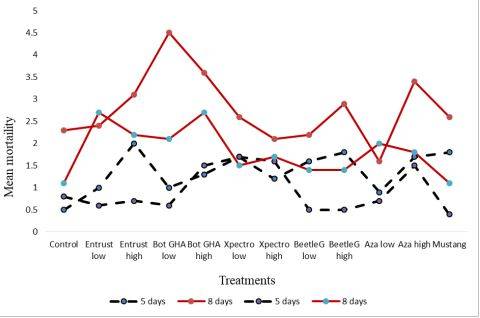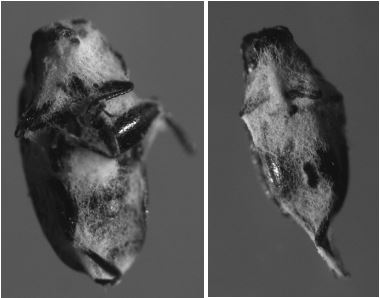Evaluation of commercially available bio-pesticides and pheromone traps for management and monitoring of crucifer flea beetles Phyllotreta cruciferae
Principal Investigator: Gadi V.P. Reddy, Michael A Ivie
Project Personnel: Anamika Sharma, John H. Miller, and Julie Prewett
Aim of the study
The first objective of this study was to test the impact of five bio-pesticides and compared them with conventional pesticide Mustang Maxx® (Zeta-cypermethrin). The bio-pesticides selected were Entrust WP® (spinosad 80%), Aza-Direct® (azadirachtin), BoteGHA® (Beauveria bassiana GHA), Xpectro® (Beauveria bassiana GHA and Pyrethrum), BeetleGONE® (Bacillus thuringiensis galleriae) on adults of crucifer flea beetles (Phyllotreta cruciferae) (Table 1). As second objective pheromone-traps (allyl isocyanate 10 mg in a nonvolatile carrier with antioxidant in a membrane release device) were installed to access the population of adult Phyllotreta cruciferae in various regions of Golden Triangle Area of Montana.
Material and Methods Study sites
Pheromone traps were installed at five sites in Conrad (WTARC; 48o 18.627’N, 111o 55.402’ W), Cut Bank (48o 30.77’N, 111o 92.55’ W), Cooley (48o 56.009’ N, 111o 40.565’ W), Havre (Northern Agriculture Research Center; 48o.32.52’ N, 109o.40 W), and Chester (48o 44.006’N, 110o 56.805’ W). The traps were installed in the fields on different dates depending on the seeding and germination of the canola crop. The installation of traps began in the last week of May 2019 and data were collected until the last week of August 2019.
Experimental design and application
The pheromone traps were installed at two heights (0.4 meters from the ground and 0.8 meter from the ground). At every site four traps were installed, two at each height. The traps were installed at a distance of 10-15 meters. The traps were collected every 15 days and new traps were installed. For bioassay, adult flea beetles were collected from the WTARC field as and when the experiment was set up. Five bio-pesticides were tested along with conventional pesticide Mustang Maxx (Table 1) against adult flea beetles. The solutions were prepared at low and high rates as per label description and applied on flea beetles directly and indirectly.
For direct application, the treatments were applied directly as a topical solution on the adult flea beetle’s body surface using 750-ml hand-held sprayers. A total of 1 ml of solution was applied in each cup after flea beetles were released in the deli plastic cups (7 cm diameter and 3.5 cm deep; 10 adults in every cup). The canola leaves were supplied to the adults. For indirect spray, the treatments were sprayed directly on the leaves (3–4 cm in length). For every treatments 15–20 leaves were sprayed and dried for 10 minutes. About 3 leaves were used in each cup and adults were released (10 adults were released in each cup). The cups were kept in the incubator (55–60% moisture and 20–22º C). The mortality was checked in 5 and 10 days.
Table 1: Materials and rates of application in each treatment applied on flea beetles directly and indirectly in 2019.
|
Treatment |
Active Ingredient |
Low Rate |
High Rate |
Source |
|
Control |
Water |
|
|
|
|
Entrust® |
Spinosad (a mixture of spinosyn A and spinosyn D) |
0.114 gms/3.78 liter |
0.65 gms/3.78 liter |
Dow AgroSciences |
|
BoteGHA® |
Beauveria bassiana GHA |
474 ml/7.57 liter |
947 ml/7.57 liter |
Certis |
|
Xpectro® |
Beauveria bassiana GHA and Pyrethrum |
474 ml/378.5 liter |
947 ml/7.57 liter |
LAM international |
|
BeetleGone® |
Bacillus thuringiensis galleriae |
113 gms/3.78 liter |
227 gms/3.78 liter |
PhyllomBioProducts |
|
Aza-Direct® |
Azadirachtin |
5.32 ml/3.78 liter |
7.99ml/ 3.78 liter |
Gowan Company |
|
Mustang Maxx® |
Zeta-cypermethrin |
0.028 ml/liter |
- |
FMC corporation |
Table 2: Mean numbers of crucifer flea beetles collected in each trap installed at two different heights at five sites in 2019.
|
Treatment |
WTARC |
Cooley |
Cut Bank |
Chester |
Havre |
|||||
|
Distance of traps from the ground |
0.4 |
0.8 |
0.4 |
0.8 |
0.4 |
0.8 |
0.4 |
0.8 |
0.4 |
0.8 |
|
1st collection (June 1– June 15) |
251 |
89 |
33 |
49 |
- |
- |
- |
- |
- |
- |
|
2nd collection (June 15–June 30) |
213 |
69 |
54 |
55 |
30 |
36 |
221 |
204 |
- |
- |
|
3rd collection (June 30–July 15) |
662 |
122 |
64 |
61 |
29 |
23 |
34 |
28 |
52 |
46 |
|
4th collection (July 14–July 30) |
1511 |
372 |
50 |
45 |
108 |
70 |
10 |
18 |
44 |
44 |
|
5th collection (July 30–August 15) |
357 |
698 |
56 |
148 |
545 |
307 |
305 |
70 |
858 |
1218 |
Table 3: Mean mortality of adult flea beetles in two set of experiments where 12 treatments were applied indirectly
|
Indirect application |
|
|
Direct application |
|||
|
|
1st experiment |
2nd experiment |
1st experiment |
|||
|
|
5 days |
8 days |
5 days |
8 days |
5 days |
8 days |
|
Control |
0.5 |
2.3 |
0.8 |
1.1 |
4.9 |
6.9 |
|
Entrust low |
1 |
2.4 |
0.6 |
2.7 |
9.1 |
9.4 |
|
Entrust high |
2 |
3.1 |
0.7 |
2.2 |
9.8 |
9.8 |
|
BoteGHA low |
1 |
4.5 |
0.6 |
2.1 |
9.6 |
9 |
|
BoteGHA high |
1.3 |
3.6 |
1.5 |
2.7 |
9.6 |
9.4 |
|
Xpectro low |
1.7 |
2.6 |
1.7 |
1.5 |
9.9 |
9.7 |
|
Xpectro high |
1.2 |
2.1 |
1.6 |
1.7 |
9.1 |
9.2 |
|
BeetleGone low |
1.6 |
2.2 |
0.5 |
1.4 |
8.4 |
8.9 |
|
BeetleGone high |
1.8 |
2.9 |
0.5 |
1.4 |
9.9 |
10.3 |
|
Aza-Direct low |
0.9 |
1.6 |
0.7 |
2 |
3.6 |
6.7 |
|
Aza-Direct high |
1.7 |
3.4 |
1.5 |
1.8 |
9.8 |
9 |
|
Mustang |
1.8 |
2.6 |
0.4 |
1.1 |
9.9 |
9.7 |
Results
At the selected five sites, the maximum population of flea beetles were captured at WTARC, where no seed treatment was applied. The maximum adults were collected from 10 July to 15 August 2019. During spring and fall (from 25 May to 30 June; from 25 July to 15 August 2019) more adults were captured by the trap at 0.8 meters height. Whereas, during summer (from June to July 2019) more numbers were captured by the traps at 0.4 meters height (Table 2; Figure 1). In the mortality assessment, in the direct application method the mortality was maximum for BeetleGone at a high rate, however, the mortality was greater for all the treatments in direct application compared to the indirect application. In indirect application, maximum mortality was caused by BoteGHA high, Aza-direct high, and Entrust low and high at 8 days. At 5 days the maximum mortality was recorded by Entrust high, Xpectro low, BoteGHA high, and Mustang (Table 2, Figures 2,3).
Conclusion
In 2018, in field experiments, Entrust caused the maximum mortality and also provided greater yield. In 2019, we tested twelve treatments in laboratory bio-assay, which included two rates (low and high) of five bio-pesticides and a single rate of Mustang Maxx. The direct application did cause greater mortality, however, we do believe that although applied in small amounts, the direct application of treatments might have caused chocking mortality to the flea beetles. In lab-bioassay, the best treatment was BoteGHA at a high rate. Other treatments including Entrust and Aza-direct
also performed well. After 8 days greater mortality is observed. Xoectro low, entrust low and high, and Mustang performed better at 5 days compared to the other treatments. For flea beetle trapping, we have tested pheromone traps at two heights. It seems the newly emerged flea beetles hop more and more numbers were collected at 0.8 meters height. A distance of 10-15 meters between traps worked well for the flea beetle pheromones.
Figure 1. Mean number of Phyllotreta cruciferae trapped in the traps at 0.4 m and 0.8 m height at five sites in 2019 (June 2019–August 2019).
Figure 2. Mean mortality of adult Phyllotreta cruciferae by indirect application of twelve treatments (n=2). The mortality observed on 5th and 8th day.
Figure 3. Fungus growth on the adult flea beetles. 1. Adult Phyllotreta cruciferae treated with BoteGha 2. Adult Phyllotreta cruciferae treated with Xpectro.
Acknowledgements
This work was supported by Montana Wheat and Barley Committee. We would like to thank summer intern Carley Ries for assistance with fieldwork.



